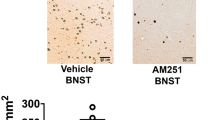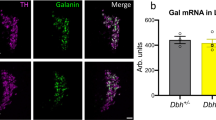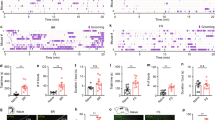Abstract
The dopamine (DA) innervation to the forebrain arises from subpopulations of midbrain DA neurones broadly classified as nigrostriatal, mesolimbic and mesocortical1. Significant differences in the autoregulatory mechanisms and neuronal inputs of these DA pathways may account for their differences in physiological and pharmacological responsiveness2. For example, foot-shock stress can activate rat mesocortical DA cells but does not alter nigrostriatal DA turnover3–5, while also decreasing substance P (SP) concentrations in the midbrain interpeduncular nucleus and in the adjacent ventral tegmental area (VTA), but not in the substantia nigra (SN)6. This suggested that the activation of the SP input to the VTA6 may mediate activation of certain DA systems by footshock stress (Fig. 1); behavioural studies also had suggested an excitatory effect of SP on DA cells in the VTA7. SP antagonists now available are neurotoxic8 and of questionable efficacy9, we therefore used monoclonal antibody against SP. Antibody microinjected into the VTA prevented normal footshock-induced activation of mesocortical DA neurones, suggesting mediation by SP input to the VTA. The in vivo application of antibodies may prove valuable in studies of neuropeptides in the central nervous system (CNS).
This is a preview of subscription content, access via your institution
Access options
Subscribe to this journal
Receive 51 print issues and online access
$199.00 per year
only $3.90 per issue
Buy this article
- Purchase on Springer Link
- Instant access to full article PDF
Prices may be subject to local taxes which are calculated during checkout
Similar content being viewed by others
References
Iversen, S. D. & Alpert, J. E. in Gilles de la Tourette Syndrome (eds Friedhoff, A. J. & Chase, T. N.) 69–76 (Raven, New York, 1982).
Bannon, M. J. & Roth, R. H. Pharmac. Rev. 35, 53–68 (1983).
Thierry, A. M., Tassin, J. P., Blanc, G. & Glowinski, J. Nature 263, 242–244 (1976).
Fadda, F. et al. Life Sci. 23, 2219–2224 (1978).
Herman, J. P. et al. Life Sci. 30, 2207–2214 (1982).
Lisoprawski, A., Blanc, G. & Glowinski, J. Neurosci. Lett. 25, 47–51 (1981).
Stinus, L., Kelley, A. E. & Iversen, S. D. Nature 276, 616–618 (1978).
Hökfelt, T. et al. Acta physiol. scand. 113, 571–573 (1981).
Salt, T. E. et al. Neurosci. Lett. 30, 291–295 (1982).
Kanazawa, I. & Jessell, T. Brain Res. 117, 362–367 (1976).
Chéramy, A. et al. Brain Res. 155, 404–408 (1978).
Bannon, M. J., Michaud, R. L. & Roth, R. H. Molec. Pharmac. 19, 270–275 (1981).
Bannon, M. J., Reinhard, J. F. Jr, Bunney, E. B. & Roth, R. H. Nature 296, 444–446 (1982).
Bannon, M. J., Wolf, M. E. & Roth, R. H. Eur. J. Pharmac. 92, 119–125 (1983).
Chiodo, L. A., Bannon, M. J., Grace, A. A., Roth, R. H. & Bunney, B. S. Neuroscience (in the press).
Eison, A. S., Eison, M. S. & Iversen, S. D. Brain Res. 238, 137–152 (1982).
Pellegrino, L. J., Pellegrino, A. S. & Cushman, A. J. A Stereotaxic Atlas of the Rat Brain (Plenum, New York, 1979).
Cuello, A. C. Galfre, G. & Milstein, C. Proc. natn. Acad. Sci. U.S.A. 76, 3532–3536 (1979).
Reinhard, J. F. Jr., Bannon, M. J. & Roth, R. H. NaunynSchmiedeberg's Archs Pharmac. 318, 374–377 (1982).
Author information
Authors and Affiliations
Rights and permissions
About this article
Cite this article
Bannon, M., Elliott, P., Alpert, J. et al. Role of endogenous substance P in stress-induced activation of mesocortical dopamine neurones. Nature 306, 791–792 (1983). https://doi.org/10.1038/306791a0
Received:
Accepted:
Issue Date:
DOI: https://doi.org/10.1038/306791a0
This article is cited by
-
Behavioral sensitization due to social defeat stress in mice: antagonism at mGluR5 and NMDA receptors
Psychopharmacology (2005)
-
Infusion of the substance P analogue, DiMe-C7, into the ventral tegmental area induces reinstatement of cocaine-seeking behaviour in rats
Psychopharmacology (2004)
-
Systemic administration of amperozide, a new atypical antipsychotic drug, preferentially increases dopamine release in the rat medial prefrontal cortex
Psychopharmacology (1994)
-
Changes of cerebral vasoactive intestinal polypeptide-and somatostatin-like immunoreactivity induced by noise and whole-body vibration in the rat
European Journal of Applied Physiology and Occupational Physiology (1994)
-
Neurotensin, substance P, neurokinin-α, and enkephalin: injection into ventral tegmental area in the rat produces differential effects on operant responding
Psychopharmacology (1989)
Comments
By submitting a comment you agree to abide by our Terms and Community Guidelines. If you find something abusive or that does not comply with our terms or guidelines please flag it as inappropriate.



